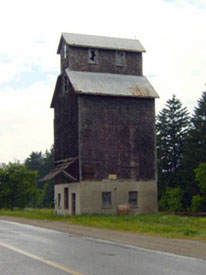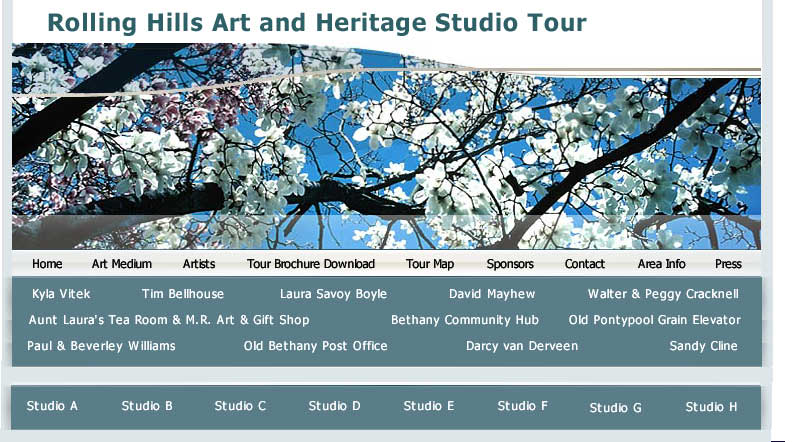|
You are invited
to tour our Manvers community while on our “Rolling Hills
Studio Tour”, which includes the villages of Pontypool and
Bethany!
Visit many of the
artists that make their home on the environmentally sensitive
area of the Oak Ridges Moraine, known as the “Jewel in the
Crown”.
You have not been
to the country until you have traveled our country roads of Manvers
Township, known officially as the ‘City of Kawartha Lakes’.
Imagine the days of ‘Yester-Year’ when life was simpler,
and these rolling hills were the peaks and valleys of one’s
life. This area is one of Ontario’s best kept secret!
PONTYPOOL
VILLAGE
Pontypool first settlers
arrived in the mid 1800’s named the village after their
home in Pontypool, Wales. It became a hub of activities of the
area farmers and business.
In the 1920-50’s
Pontypool was known as a summer resort for hundreds of from the
Jewish community in Toronto. Doctors prescribed stays at the
resort as the climate and conditions seemed to alleviate rheumatism
and asthmatic conditions. It also has been said that the waters
seem to have a special healing effect.
Many a Jewish family
took the train to Pontypool for the weekends. Fathers often brought
their families to stay the week to latter join them the following
weekends. Cottages sprang up around the ‘Big Pond’.
About 5 acres of spring water was the playground for these families
who also enjoyed dances, playing cards and summer weekend entertainment.
Today this pond has
all but dried-up the, resort community has disappeared and the
Jewish Synagogue built for this seasonal community no longer
stands. However, great memories still remain! In 2005, a reunion
of over 700 came back to Pontypool who enjoyed this unique Jewish
Resort. Many a childhood summer memories were born and nurtured
here.
 THE PONTYPOOL HISTORICAL GRAIN ELEVATOR THE PONTYPOOL HISTORICAL GRAIN ELEVATOR
Bring your camera
for a picture of our historical Grain Elevator and its unique
construction!
Canadian Pacific Railway,
has given the elevator to the "Friends of the Pontypool
Elevator" heritage group. They are hoping to have the structure
declared a historic site.
“The Pontypool
Grain Elevator was built in 1918 and is located at Hwy 35 and
Pontypool Rd. It is one of two free standing elevators remaining
in Ontario as a reminder of the agricultural roots of the community.
Once restored it will become a tourist information centre and
the Jewish Museum recognizing those Jewish citizens who summered
in Pontypool 1920-1960.” As per Kathy Morton Manvers Historical
Society
BETHANY
VILLAGE
As throughout history,
towns and villages sprang up around the railway system. In the
mid 1800’s the wood burning ‘Iron Horse’ as it
was once known, traveling at 60 miles an hour, became the centre
point of Bethany Village.
When settlers debated
over the name they should give to their village Mr. McAllister,
who was a very Godly man made mention of the adjoining villages,
said “Hebron and Bethel to the north and west, let us call
this place Bethany in accordance with all the other Biblical
names, for it has an appropriate setting among wooded hills and
is nigh unto the other.” And so to the young settlement
the name of Bethany was given” as per “The Rolling
Hills” book by the Rolling Hills Historical Society
To this day, you will
still find Bethany among wooded hills and famous for its beautiful
rolling hills. “The Old Bethany Post Office at 1480 Hwy
7A Bethany is the only restored free standing heritage post office
in Ontario. It was built in the 1870’s. A Heritage Garden
is planned to celebrate the 150th Anniversary of Bethany this
year”. As per Kathy Morton Manvers Rolling Hills Historical
Society
SIGNIFIGANCE
OF THE OAK RIDGES MORAINE
The Oak Ridges Moraine
Oak Ridges Moraine conjures up images of rolling hills, scenic
vistas and spectacular fall foliage, stretching 160 Kilometers
from the Niagara Escapement east thought the Greater Toronto
Area to the Rice Lake Plains. 30% is forest covered and are a
key natural landscape in southern Ontario. It is described as
the most southern ‘Rain barrel’.
Drive the rolling
hills and envision the ‘Great Wisconson Glacier’ of
10 million years ago that etched it way as it's advanced and
retreated through this land pushing rock and gravel to provide
for us today a filter of our very own drinking water.
One of the moraine's
most important functions is as a water recharge/discharge area
- sustaining the health of the many watersheds, which originate
in the moraine and directly providing drinking water to over
250,000 people. Its permeable sands and gravels absorb and collect
precipitation, which slowly recharge the deep aquifers below
the ground. Over five million people live on or near it, rely
on this drinking water.
The forests, savannahs,
prairies, wetlands, lakes and streams of the Oak Ridges Moraine
provide habitat for many plant and animal species, of which 77
are imperiled provincially or nationally, including rarities
such as West Virginia White Butterfly, Jefferson Salamander,
Red-shouldered Hawk and American Ginseng. A concentration of
provincially rare wetlands within the Oak Ridges Moraine support
plants and insects more typical of northern Ontario and the remnant
tall grass prairie and oak-pine savannah occurring in the eastern
portion are recognized as globally threatened ecosystems.
CAVAN
The original township
of Cavan and Millbrook was surveyed by John Deyell in 1817, and
was named after County Cavan in Ireland, from which many of its
settlers had emigrated. By 1819 there were 244 settlers, and
by 1861 the population had risen to 4901, many of whom were descendants
of United Empire Loyalists, veterans of the War of 1812 who had
been granted land there, or the original and later settlers from
Ireland. After Confederation in 1867, the population began to
drop as many families left for Western Canada.
The original Irish
settlers were Protestants, and many of them were associated with
the Orange Order. In the mid-19th century the "Cavan Blazers"
were established as a fiercely Protestant vigilante group, who
often burned down the farms of Catholic settlers. |

